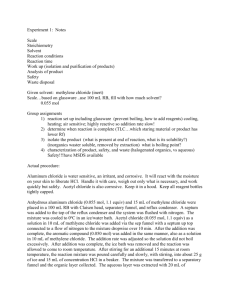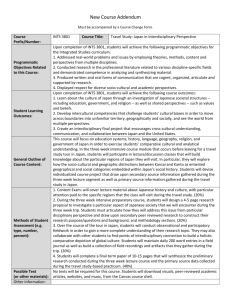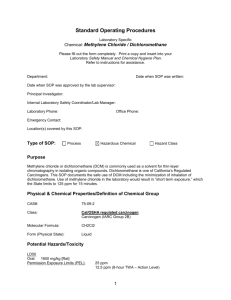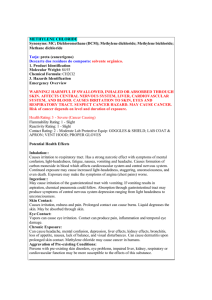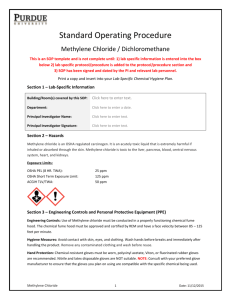SCBT MSDS
advertisement
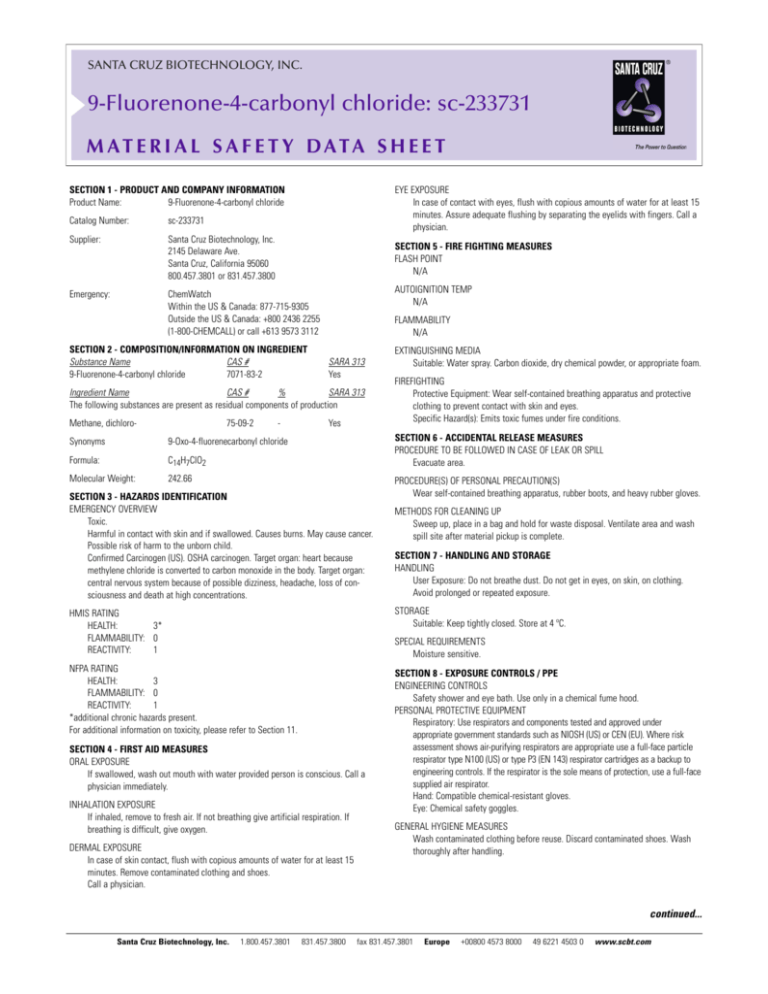
SANTA CRUZ BIOTECHNOLOGY, INC. 9-Fluorenone-4-carbonyl chloride: sc-233731 M AT E R I A L S A F E T Y DATA S H E E T SECTION 1 - PRODUCT AND COMPANY INFORMATION Product Name: 9-Fluorenone-4-carbonyl chloride EYE EXPOSURE In case of contact with eyes, flush with copious amounts of water for at least 15 minutes. Assure adequate flushing by separating the eyelids with fingers. Call a physician. Catalog Number: sc-233731 Supplier: Santa Cruz Biotechnology, Inc. 2145 Delaware Ave. Santa Cruz, California 95060 800.457.3801 or 831.457.3800 Emergency: ChemWatch Within the US & Canada: 877-715-9305 Outside the US & Canada: +800 2436 2255 (1-800-CHEMCALL) or call +613 9573 3112 SECTION 5 - FIRE FIGHTING MEASURES FLASH POINT N/A SECTION 2 - COMPOSITION/INFORMATION ON INGREDIENT Substance Name CAS # 9-Fluorenone-4-carbonyl chloride 7071-83-2 AUTOIGNITION TEMP N/A FLAMMABILITY N/A SARA 313 Yes Ingredient Name CAS # % SARA 313 The following substances are present as residual components of production Methane, dichloro- 75-09-2 - Synonyms 9-Oxo-4-fluorenecarbonyl chloride Formula: C14H7ClO2 Molecular Weight: 242.66 Yes EXTINGUISHING MEDIA Suitable: Water spray. Carbon dioxide, dry chemical powder, or appropriate foam. FIREFIGHTING Protective Equipment: Wear self-contained breathing apparatus and protective clothing to prevent contact with skin and eyes. Specific Hazard(s): Emits toxic fumes under fire conditions. SECTION 6 - ACCIDENTAL RELEASE MEASURES PROCEDURE TO BE FOLLOWED IN CASE OF LEAK OR SPILL Evacuate area. SECTION 3 - HAZARDS IDENTIFICATION EMERGENCY OVERVIEW Toxic. Harmful in contact with skin and if swallowed. Causes burns. May cause cancer. Possible risk of harm to the unborn child. Confirmed Carcinogen (US). OSHA carcinogen. Target organ: heart because methylene chloride is converted to carbon monoxide in the body. Target organ: central nervous system because of possible dizziness, headache, loss of consciousness and death at high concentrations. PROCEDURE(S) OF PERSONAL PRECAUTION(S) Wear self-contained breathing apparatus, rubber boots, and heavy rubber gloves. METHODS FOR CLEANING UP Sweep up, place in a bag and hold for waste disposal. Ventilate area and wash spill site after material pickup is complete. SECTION 7 - HANDLING AND STORAGE HANDLING User Exposure: Do not breathe dust. Do not get in eyes, on skin, on clothing. Avoid prolonged or repeated exposure. STORAGE Suitable: Keep tightly closed. Store at 4 ºC. HMIS RATING HEALTH: 3* FLAMMABILITY: 0 REACTIVITY: 1 SPECIAL REQUIREMENTS Moisture sensitive. NFPA RATING HEALTH: 3 FLAMMABILITY: 0 REACTIVITY: 1 *additional chronic hazards present. For additional information on toxicity, please refer to Section 11. SECTION 4 - FIRST AID MEASURES ORAL EXPOSURE If swallowed, wash out mouth with water provided person is conscious. Call a physician immediately. INHALATION EXPOSURE If inhaled, remove to fresh air. If not breathing give artificial respiration. If breathing is difficult, give oxygen. DERMAL EXPOSURE In case of skin contact, flush with copious amounts of water for at least 15 minutes. Remove contaminated clothing and shoes. Call a physician. SECTION 8 - EXPOSURE CONTROLS / PPE ENGINEERING CONTROLS Safety shower and eye bath. Use only in a chemical fume hood. PERSONAL PROTECTIVE EQUIPMENT Respiratory: Use respirators and components tested and approved under appropriate government standards such as NIOSH (US) or CEN (EU). Where risk assessment shows air-purifying respirators are appropriate use a full-face particle respirator type N100 (US) or type P3 (EN 143) respirator cartridges as a backup to engineering controls. If the respirator is the sole means of protection, use a full-face supplied air respirator. Hand: Compatible chemical-resistant gloves. Eye: Chemical safety goggles. GENERAL HYGIENE MEASURES Wash contaminated clothing before reuse. Discard contaminated shoes. Wash thoroughly after handling. continued... Santa Cruz Biotechnology, Inc. 1.800.457.3801 831.457.3800 fax 831.457.3801 Europe +00800 4573 8000 49 6221 4503 0 www.scbt.com SECTION 9 - PHYSICAL/CHEMICAL PROPERTIES Form . . . . . . . . . . . . . . . . . . . . . . . . . . . . . . . .Solid pH . . . . . . . . . . . . . . . . . . . . . . . . . . . . . . . . . .N/A BP/BP Range . . . . . . . . . . . . . . . . . . . . . . . . .N/A MP/MP Range . . . . . . . . . . . . . . . . . . . . . . . .139,000. - 141,000 °C Freezing Point . . . . . . . . . . . . . . . . . . . . . . . . .N/A Vapor Pressure . . . . . . . . . . . . . . . . . . . . . . . .N/A Vapor Density . . . . . . . . . . . . . . . . . . . . . . . . .N/A Saturated Vapor Conc. . . . . . . . . . . . . . . . . . .N/A Bulk Density . . . . . . . . . . . . . . . . . . . . . . . . . .N/A Odor Threshold . . . . . . . . . . . . . . . . . . . . . . . .N/A Volatile% . . . . . . . . . . . . . . . . . . . . . . . . . . . .N/A VOC Content . . . . . . . . . . . . . . . . . . . . . . . . . .N/A Water Content . . . . . . . . . . . . . . . . . . . . . . . .N/A Solvent Content . . . . . . . . . . . . . . . . . . . . . . .N/A Evaporation Rate . . . . . . . . . . . . . . . . . . . . . .N/A Viscosity . . . . . . . . . . . . . . . . . . . . . . . . . . . . .N/A Surface Tension . . . . . . . . . . . . . . . . . . . . . . .N/A Partition Coefficient . . . . . . . . . . . . . . . . . . . .N/A Decomposition Temp. . . . . . . . . . . . . . . . . . .N/A Flash Point . . . . . . . . . . . . . . . . . . . . . . . . . . .N/A Explosion Limits . . . . . . . . . . . . . . . . . . . . . . .N/A Flammability . . . . . . . . . . . . . . . . . . . . . . . . . .N/A Autoignition Temp . . . . . . . . . . . . . . . . . . . . .N/A Refractive Index . . . . . . . . . . . . . . . . . . . . . . .N/A Optical Rotation . . . . . . . . . . . . . . . . . . . . . . .N/A Miscellaneous Data . . . . . . . . . . . . . . . . . . . .N/A Solubility . . . . . . . . . . . . . . . . . . . . . . . . . . . .N/A N/A = not available CONDITIONS AGGRAVATED BY EXPOSURE Existing data suggests that methylene chloride may be a weak mutagen in mammalian systems. CHRONIC EXPOSURE - CARCINOGEN Result: This is or contains a component that has been reported to be carcinogenic based on its IARC, OSHA, ACGIH, NTP, or EPA classification. CHRONIC EXPOSURE - TERATOGEN Result: Possible risk of congenital malformation in the fetus. SECTION 12 - ECOLOGICAL INFORMATION No data available. SECTION 13 - DISPOSAL CONSIDERATIONS APPROPRIATE METHOD OF DISPOSAL OF SUBSTANCE OR PREPARATION Contact a licensed professional waste disposal service to dispose of this material. Dissolve or mix the material with a combustible solvent and burn in a chemical incinerator equipped with an afterburner and scrubber. Observe all federal, state, and local environmental regulations. SECTION 14 - TRANSPORT INFORMATION DOT Proper Shipping Name: Corrosive solid, acidic, organic, n.o.s. UN#: 3261 Class: 8 Packing Group: Packing Group II Hazard Label: Corrosive PIH: Not PIH IATA Proper Shipping Name: Corrosive solid, acidic, organic, n.o.s. IATA UN Number: 3261 Hazard Class: 8 Packing Group: II SECTION 10 - STABILITY AND REACTIVITY STABILITY Conditions of Instability: May decompose on exposure to moist air or water. Materials to Avoid: Strong oxidizing agents, Strong bases. HAZARDOUS DECOMPOSITION PRODUCTS Hazardous Decomposition Products: Carbon monoxide, Carbon dioxide, Hydrogen chloride gas. HAZARDOUS POLYMERIZATION Hazardous Polymerization: Will not occur SECTION 11 - TOXICOLOGICAL INFORMATION ROUTE OF EXPOSURE Skin Contact: Causes burns. Skin Absorption: May be harmful if absorbed through the skin. Eye Contact: Causes burns. Inhalation: Material is extremely destructive to the tissue of the mucous membranes and upper respiratory tract. May be harmful if inhaled. Ingestion: May be harmful if swallowed. TARGET ORGAN(S) OR SYSTEM(S) Pancreas. Target organ: central nervous system because of possible dizziness, headache, loss of consciousness and death at high concentrations. Target organ: heart because methylene chloride is converted to carbon monoxide in the body. Liver. SIGNS AND SYMPTOMS OF EXPOSURE Material is extremely destructive to tissue of the mucous membranes and upper respiratory tract, eyes, and skin. Inhalation may result in spasm, inflammation and edema of the larynxand bronchi, chemical pneumonitis, and pulmonary edema. Symptoms of exposure may include burning sensation, coughing, wheezing, laryngitis, shortness of breath, headache, nausea, and vomiting. Dichloromethane is metabolized in the body producing carbon monoxide which increases and sustains carboxyhemoglobin levels in the blood, reducing the oxygen-carrying capacity of the blood. To the best of our knowledge, the chemical, physical, and toxicological properties have not been thoroughly investigated. SECTION 15 - REGULATORY INFORMATION EU ADDITIONAL CLASSIFICATION Symbol of Danger: C Indication of Danger: Corrosive. R: 34-40 Risk Statements: Causes burns. Limited evidence of a carcinogenic effect. S: 26-36/37/39-45 Safety Statements: In case of contact with eyes, rinse immediately with plenty of water and seek medical advice. Wear suitable protective clothing, gloves, and eye/face protection. In case of accident or if you feel unwell, seek medical advice immediately (show the label where possible). US CLASSIFICATION AND LABEL TEXT Indication of Danger: Toxic. Risk Statements: Harmful in contact with skin and if swallowed. Causes burns. May cause cancer. Possible risk of harm to the unborn child. Safety Statements: In case of contact with eyes, rinse immediately with plenty of water and seek medical advice. Wear suitable protective clothing, gloves, and eye/face protection. In case of accident or if you feel unwell, seek medical advice immediately (show the label where possible). US Statements: Confirmed Carcinogen (US). OSHA carcinogen. Target organ: heart because methylene chloride is converted to carbon monoxide in the body. Target organ: central nervous system because of possible dizziness, headache, loss of consciousness and death at high concentrations. UNITED STATES REGULATORY INFORMATION SARA LISTED: Yes NOTES: This product is or contains a component that is subject to SARA313 reporting requirements. UNITED STATES - STATE REGULATORY INFORMATION OSHA Remarks: OSHA-regulated carcinogen. See CFR title 29 part 1910.1052. continued... Santa Cruz Biotechnology, Inc. 1.800.457.3801 831.457.3800 fax 831.457.3801 Europe +00800 4573 8000 49 6221 4503 0 www.scbt.com CALIFORNIA PROP - 65 California Prop - 65: This product is or contains chemical(s) known to the state of California to cause cancer. CANADA REGULATORY INFORMATION WHMIS Classification: This product has been classified in accordance with the hazard criteria of the CPR, and the MSDS contains all the information required by the CPR. DSL: No NDSL: No SECTION 16 - OTHER INFORMATION The above information is believed to be correct but does not purport to be complete and should be used only as a guide. The burden of safe use of this material rests entirely with the user. 8/13/2012 Santa Cruz Biotechnology, Inc. 1.800.457.3801 831.457.3800 fax 831.457.3801 Europe +00800 4573 8000 49 6221 4503 0 www.scbt.com

